A shark scientist reflects on Jaws at 50

We’re still afraid to go in the water
Ars chats with marine biologist David Shiffman about the film’s legacy—both good and bad.
Roy Scheider starred as Chief Martin Brody in the 1975 blockbuster Jaws.
Credit:
Universal Pictures
Today marks the 50th anniversary of Jaws, Steven Spielberg’s blockbuster horror movie based on the bestselling novel by Peter Benchley. We’re marking the occasion with a tribute to this classic film and its enduring impact on the popular perception of sharks, shark conservation efforts, and our culture at large.
(Many spoilers below.)
Jaws tells the story of Chief Martin Brody (Roy Scheider), the new police chief for Amity Island, a New England beach town and prime summer tourist attraction. But that thriving industry is threatened by a series of shark attacks, although the local mayor, Larry Vaughn (Murray Hamilton), initially dismisses the possibility, ridiculing the findings of visiting marine biologist Matt Hooper (Richard Dreyfuss). The attacks keep escalating and the body count grows, until the town hires a grizzled shark hunter named Quint (Robert Shaw) to hunt down and kill the great white shark, with the help of Brody and Hooper.
Benchley wrote his novel after reading about a sports fisherman named Frank Mundus, who captured a very large shark in 1964; in fact, the character of Quint is loosely based on Mundus. Benchley wrote an early draft of the screenplay, which underwent multiple revisions during production. In the end, he estimated that his contributions amounted to the basic storyline and the mechanics. Spielberg wasn’t the studio’s first choice for director; initially they hired Dick Richards, but Richards kept referring to the shark as a whale. Eventually, he was fired and replaced with the 26-year-old Spielberg, who had just finished his first feature film (The Sugarland Express).
Spielberg was given a $3.5 million shooting budget and a timeframe of 55 days for filming. However, the production was troubled from the start, largely due to the director’s insistence on shooting on location in Martha’s Vineyard; Jaws was the first major film to be shot on the ocean. Spielberg later admitted, “I was pretty naive about Mother Nature and the hubris of a filmmaker who thinks he can conquer the elements was foolhardy.” Unwanted boats kept drifting into the frame; cameras kept getting waterlogged; Carl Gottlieb (who played the local news editor Meadows) was nearly decapitated by a propeller; Dreyfuss nearly got stuck in the shark cage; and several actors suffered from seasickness. Frustrated crew members took to calling the movie “Flaws.”
A shark strikes
“duh-duh-duh-duh-duh-duh….”
Universal Pictures
There were three pneumatically powered full-sized mechanical sharks built for the shoot, nicknamed “Bruce,” and they kept malfunctioning. The pneumatic hoses kept taking on seawater; the skin was made of neoprene foam, which soaked up water and became bloated; and one of the models kept getting tangled up in seaweed. In the end, Spielberg opted to shoot most of the early scenes without ever showing the actual shark, which actually heightened the tension and suspense, especially when combined with John Williams’ ominous theme music (“duh-duh-duh-duh-duh-duh…”).
In the end, shooting ran for 159 days, and the budget ballooned to $9 million. All the delays gave Spielberg and his writers (especially Gottlieb) extra time to refine the script, often just prior to filming the scenes. A lot of the dialogue was improvised by the actors. And it was all worth it in the end, because Jaws went on to become a major summer box office success. All told, it grossed $476 million globally across all its theatrical releases and won three Oscars, although it lost Best Picture to One Flew Over the Cuckoo’s Nest.
Jaws inspired many, many subsequent films, including Ridley Scott’s Alien in 1979, described in pitch meetings as “Jaws in space. Audience reactions were often extreme, with many people becoming fearful of swimming in the ocean for fear of sharks. And while the sequels were, shall we say, underwhelming, the original Jaws has stood the test of time. Ars spoke with marine biologist and shark conservationist David Shiffman, author of Why Sharks Matter, to discuss the film’s depiction of sharks and its enduring place in popular culture.
Ars Technica: Let’s start by talking about the enormous impact of the film, both good and bad, on the general public’s awareness of sharks.
David Shiffman: A lot of folks in both the marine science world and the ocean conservation communities have reported that Jaws in a lot of ways changed our world. It’s not that people used to think that sharks were cute, cuddly, adorable animals, and then after Jaws, they thought that they were bloodthirsty killing machines. They just weren’t on people’s minds. Fishermen knew about them, surfers thought about them, but that was about it. Most people who went to the beach didn’t pay much mind to what could be there. Jaws absolutely shattered that. My parents both reported that the summer that Jaws came out, they were afraid to go swimming in their community swimming pools.
No, really, the water’s fine!
“You knew.” The young boy’s mother (Lee Fierro) confronts Brody.
Universal Pictures
David Shiffman: I have encountered people who were so scared that they were afraid to go in the bathtub. A lot of movies are very scary, but they don’t have that real-world impact. I love Jurassic Park, but I’m not afraid that a T. rex is going to eat me when I go into an outhouse, even though that’s about as realistic as what’s portrayed in Jaws. There’s something called the “Jaws Effect” in public policy literature, which is a way of measuring how fictional portrayals of real-world issues affect what citizens think about that issue and what policy preferences they support as a result. It’s fascinating how a fictional portrayal can do that, because I cannot stress enough: That is not what sharks look like or how they behave.
The movie also was the first time that a scientist was the hero. People half a generation above me have reported that seeing Richard Dreyfuss’ Hooper on the big screen as the one who saves the day changed their career trajectory. “You can be a scientist who studies fish. Cool. I want to do that.” In the time since Jaws came out, a lot of major changes have happened. One is that shark populations have declined globally by about 50 percent, and many species are now critically endangered.
And shark science has become much more professionalized. The American Elasmobranch Society—I’m on the board of directors—was founded in 1983, and now we have about 500 members in the US, Canada ,and Mexico. There have since been subsequent organizations founded in Australia and the Pacific Islands, Europe, South America, and a new one starting this year in Asia.
And then, from a cultural standpoint, we now have a whole genre of bad shark movies.
Ars Technica: Sharknado!
David Shiffman: Yes! Sharknado is one of the better of the bunch. Sitting on my desk here, we’ve got Sharkenstein, Raiders of the Lost Shark, and, of course, Shark Exorcist, all from the 2010s. I’ve been quoted as saying there’s two types of shark movie: There’s Jaws and there’s bad shark movies.
Ars Technica: Populations of the tiger shark, the great white, and couple of other species have declined so dramatically that many are on the verge of extinction. Is it just a coincidence that those declines started shortly after Jaws came out?
David Shiffman: The short answer is not that Jaws caused this, but that perhaps Jaws made it easier for it to happen because people weren’t outraged the way they might’ve been if it happened to say, whales, whose populations were also declining around the same time. The number one threat to shark species as a whole is unsustainable overfishing practices. People are killing too many sharks. Sustainable fisheries for sharks can and do exist, and the US largely has done a good job with this, but around the world, it’s a bad scene.
“A whole genre of bad shark movies”
For instance, shark fin soup started to be a problem around the 1980s thanks to the economic boom in China and the emergence of a new middle class there. Shark fin soup is a traditional Chinese and Southeast Asian delicacy. It’s associated with the emperor and his court. It’s not shark meat that’s used. It’s the little skeletal fin rays from the fins that are basically a bland, noodle-like substance when they’re dried and boiled. The purpose of this was for people to say, “I have so much money that I can eat these incredibly rare delicacies.” That was not caused by Jaws. But perhaps it was allowed to happen because there was less public sympathy for sharks.
It’s worth noting that shark fin soup and the shark fin trade is no longer the biggest or only threat to sharks. It hasn’t been in about 20 years. Ironically, a lot of that has to do with Chinese government efforts not to save the ocean, but to crack down on public corruption. A lot of government officials used to throw extravagant banquets for their friends and family. The new Chinese government said, “We’re not doing that anymore.” That alone saved a lot of endangered species. It was not motivated by concern about the state of the ocean, but it had that effect.
Ars Technica: People have a tendency to think that sharks are simply brutal killing machines. Why are they so important to the ecosystem?
David Shiffman: The title of my book is Why Sharks Matter because sharks do matter and people don’t think about them that way. These are food chains that provide billions of humans with food, including some of the poorest humans on Earth. They provide tens of millions of humans with jobs. When those food chains are disrupted, that’s bad for coastal communities, bad for food security and livelihoods. If we want to have healthy ocean food chains, we need a healthy top of the food chain, because when you lose the top of the food chain, the whole thing can unravel in unpredictable, but often quite devastating ways.
So sharks play important ecological roles by holding the food chain that we all depend on in place. They’re also not a significant threat to you and your family. More people in a typical year die from flower pots falling on their head when they walk down the street. More people in a typical year die falling off a cliff when they’re trying to take a selfie of the scenery behind them, than are killed by sharks. Any human death or injury is a tragedy, and I don’t want to minimize that. But when we’re talking about global-scale policy responses, the relative risk versus reward needs to be considered.
Ars Technica: There’s a scene in Jaws where Hooper is talking about his personal theory: territoriality, the idea that this rogue great white came in and made this his personal territory and now he’ll just keep feeding until the food runs out. Is that a real scientific premise from the 1970s and how valid is it?
The hunt begins
The town hires grizzled shark hunter Quint (Robert Shaw) to kill the great white shark.
Universal Pictures
David Shiffman: Rogue sharks are nonsense. It is nonsense that is still held by some kooks who are ostensibly in my field, but it is not supported by any evidence whatsoever. In all of recorded human history, there is proof that exactly one shark bit more than one human. That was the Sharm el-Sheikh attacks around Christmas in Egypt a few years ago. Generally speaking, a lot of times it’s hard to predict why wild animals do or don’t do anything. But if this was a behavior that was real, there would be evidence that it happens and there isn’t any, despite a lot of people looking.
Was it commonly believed in the 1970s? No. Did Peter Benchley make it up? No. It’s a thing in some animals for sure. In some neighborhoods, people will pick up gators and move them hundreds of miles away; the gators will move back to that exact same spot. I think the same thing has been shown with bears. Wolves certainly have a home range. But for sharks, it’s not a thing.
Ars Technica: Quint has a famous monologue about surviving the USS Indianapolis sinking and witnessing crew members being eaten by sharks. How historically accurate is that?.
David Shiffman: We don’t really know how many of the people who were killed following the sinking of the Indianapolis were killed by sharks. Certainly, firsthand accounts report that sharks were present. But those people were in the water because they were on a boat that exploded after being hit by a torpedo. That is not good for your health. So a lot of those people were either mortally wounded or killed by that initial explosion, and then perhaps were scavenged by sharks. Those are also people who are in the water bleeding, making a lot of noise. That’s an incredible scene in the movie. But the deaths Quint attributes to sharks is more people than have been reliably documented as killed by sharks in the history of the world ever.
Ars Technica: How accurate is Jaws in terms of how and why sharks attack humans? For instance, someone says that people splashing in the water mimics what sharks want to hunt.
David Shiffman: Anyone who tells you they know exactly why a wild animal does or does not do something is someone who you should be a little skeptical of. But a leading theory, which I think makes sense, is this idea of mistaken identity. Some of the people who are most commonly bitten by sharks, though it’s still astronomically rare, are surfers. These are people who are cutting through the water with a silhouette that resembles a seal, wearing black neoprene, which is modeled after seal blubber. Sharks have been patrolling the ocean since before there were trees on land, and it’s only in the last hundred years or so that they’ve had to wonder, is that my preferred prey, or is it a human using technology to mimic my preferred prey for recreational purposes?
If you’ve been in the ocean, there’s been a shark not that far from you, and it knew you were there, and you probably had no idea it was there and had a pleasant day in the water. The sharks that do bite people, they take a little bite and they go, what is that? And swim away. That can be real bad if it hits a major artery or if you’re far from shore. Again, I don’t want to minimize the real harm. But it is not a shark hunting you because it has a taste for human flesh. They don’t have hands. They explore their environment with their mouths and most things in their environment they can eat.
I think Mythbusters tested fish blood versus mammal blood versus chicken blood, I think. And the sharks were attracted to fish blood and had no reaction to the others. So these are animals that are very, very, very well adapted for environmental conditions that in some cases don’t really exist anymore.
Man vs. great white
Brody fights off an increasingly aggressive great white.
Universal Pictures
With humans, most of the time, what happens is an immediate bite, and then they swim away. With seals or large prey, they’ll often hit it really hard from below, sometimes knocking it completely out of the water. Or if they’re hunting whales or something that they can’t fit in their mouth, they just take a huge bite and swim away. With fish, they swallow them whole to the extent possible. Sometimes there’s a shaking motion to snap a neck or whatever. You see that with some land predators, too. It’s nothing like what’s seen there—but what an awesome scene.
Ars Technica: What is your favorite scene in Jaws and the one that makes you cringe the most?
David Shiffman: Oh, man. It’s really a great movie, and it holds up well. It was hailed as revolutionary at the time because you hardly ever see the shark. But the reason they did that was because the model of the shark that they built kept breaking. So they decided, let’s just shoot it from the shark’s eye view and save money and annoyance. I love the scene when Hooper realizes that the tiger shark that they’ve caught is obviously not the right species and the reaction that people have to that—just this idea that science and expertise can be used to solve problems. Whenever a shark bites someone, there are people who go out and kill any shark they can find and think that they’re helping.
One of my favorite professional experiences is the American Alasdair Rank Society conference. One year it was in Austin, Texas, near the original Alamo Drafthouse. Coincidentally, while we were there, the cinema held a “Jaws on the Water” event. They had a giant projector screen, and we were sitting in a lake in inner tubes while there were scuba divers in the water messing with us from below. I did that with 75 professional shark scientists. It was absolutely amazing. It helped knowing that it was a lake.
Ars Technica: If you wanted to make another really good shark movie, what would that look like today?
David Shiffman: I often say that there are now three main movie plots: a man goes on a quest, a stranger comes to town, or there’s a shark somewhere you would not expect a shark to be. It depends if you want to make a movie that’s actually good, or one of the more fun “bad” movies like Sharknado or Sharktopus or Avalanche Sharks—the tagline of which is “snow is just frozen water.” These movies are just off the rails and absolutely incredible. The ones that don’t take themselves too seriously and are in on the joke tend to be very fun. But then you get movies like Netflix’s Under Paris (2024); they absolutely thought they were making a good movie and took themselves very seriously, and it was painful to watch.
I would love to see actual science and conservation portrayed. I’d love to see species that are not typically found in these movies featured. The Sharknado series actually did a great job of this because they talked with me and other scientists after the success of the first one. Sharknado II is thanked in my PhD dissertation, because they funded one of my chapters. In that movie, it’s not just great whites and tiger sharks and bull sharks. They have a whale shark that falls out of the sky and hits someone. They have a cookie-cutter shark that falls out of the sky and burrows through someone’s leg. There’s a lot of shark diversity out there, and it’d be nice to get that featured more.
Jennifer is a senior writer at Ars Technica with a particular focus on where science meets culture, covering everything from physics and related interdisciplinary topics to her favorite films and TV series. Jennifer lives in Baltimore with her spouse, physicist Sean M. Carroll, and their two cats, Ariel and Caliban.












